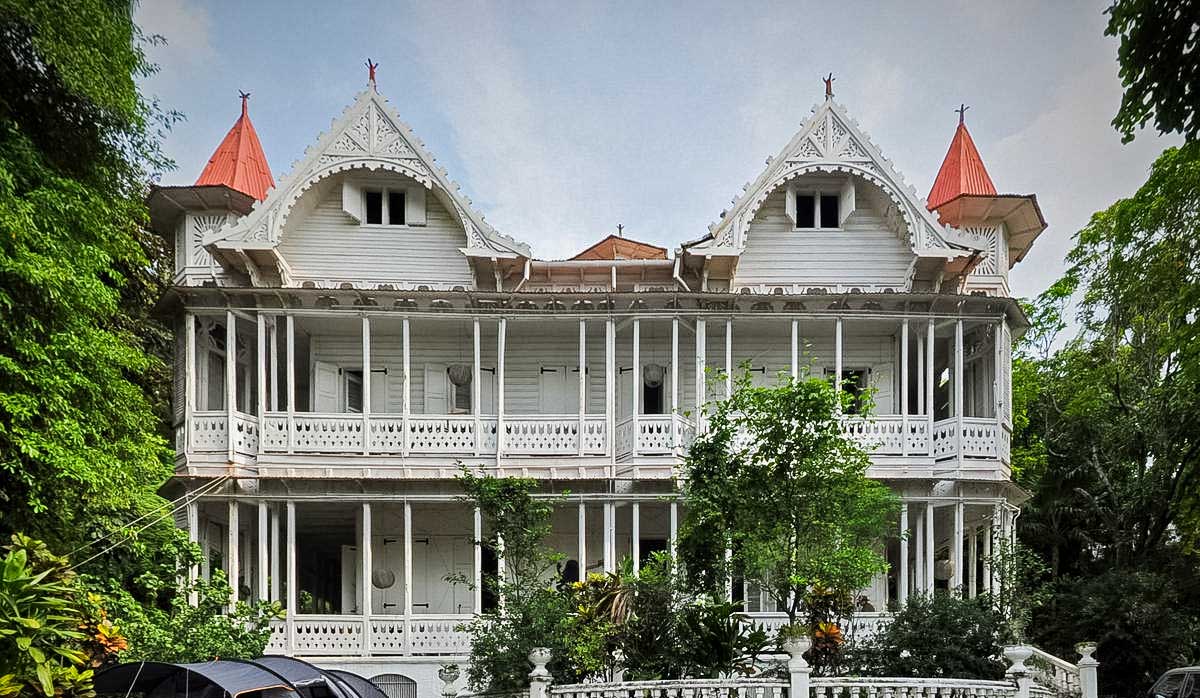
Photo: Verdy Verna
The Peabody House – A Gingerbread Palace
Constructed at the turn of the century, the delightful Peabody House is Haiti’s most famous example of a celebrated architectural form unique to the Caribbean.
Called ‘Gingerbread Houses,’ the high turrets, wraparound balconies, window peaks and lace-like lattice work make these tropical mansions into works of art.
Take a closer look
Situated in the main street of Pacot in the outskirts of Port-au-Prince, the Peabody House is almost completely obscured from the road. The house is set well into its block on Rue Garoute and surrounded by enough tropical palms that you wouldn’t be able to see it unless you knew what to look for.
Once inside the gate, you’ll notice a dozen large orb lamps hanging from wraparound porches on both levels. They punctuate the high French doors and draw the gaze to a focal point in what could otherwise be an overwhelming first impression. Large green palms rise to frame the wonderful architecture and add a lush air of luxury. Every part of the design has been carefully thought-through, and there’s no substitute for seeing it up close.
Walking up the cobblestone driveway towards the white three-story mansion, Peabody House rises up like a lavish palace. The pastel color scheme and cantilevered balconies might give you the sense that it’s more decorative than practical, but once you step onto the expansive porch you get a sense of the genius behind the design.

Photo: World Monuments Fund
Comfort is key
The gingerbread design maximises air and light. Sunshine spills into the open-plan rooms, and cool air circulates throughout. Since Haiti is hot most of the year, the Peabody House, like all gingerbread houses built around Port-au-Prince, has high ceilings, windows and doors. Carved holes notched into the top of each door allow even more air to flow through.
Peabody House is without a doubt one of architect Leon Mathon’s most masterful gingerbread designs in all of Haiti. He built it in 1912 for Gustav Keitel. Originally named “Bismarchshock,” it was painstakingly restored in the 60s by American designer-decorator, Lawrence Peabody, and promptly renamed in gratitude.
You might say that gingerbreads are the original open-concept homes. On each of the house’s three levels, interior rooms open onto multiple wide, covered balconies. The high ceilings and broad, open windows allows breezes to blow freely through the entire house.
Wide shutters are thrown open onto views of the leafy green garden and a generously-sized swimming pool. It was inside a house just like this that Napoleon Bonaparte’s sister Pauline lived during her residence in Cap-Haïtien.
A flourishing national architectural style
Gingerbreads have been called “Haiti’s endangered species” and stalking the streets of Pacot in hope of a glimpse is a worthy way to spend an afternoon.
Hundreds of gingerbread mansions like Peabody House were built in Port-au-Prince, but no two are alike. One of the easiest ways you can visit these wonders is by heading to Pacot. It’s a largely residential neighborhood in Port-au-Prince, where most of the former gingerbread mansions have been converted into hotels like the Oloffson, art galleries such as El Saeih, and restaurants – including the fittingly-named Gingerbread.
What each house has in common is imaginative and delicate designs carved out of wood. Each mansion reflects the individuality of its owner and, importantly, it reflects the spirit of the day. In post-1804 independence Haiti, architecture was used to differentiate the island identity from that of France. They adapted different styles and a keen eye can distinguish subsets of architectural formalities that can be found from Jeremie to Jacmel to Cap-Haïtien. Gingerbread houses remain uniquely Haitian.
Light, air and love
Although they top the list of Haiti’s most recognised cultural heritage, the survival of gingerbread houses is under threat. Regular and expensive maintenance – everything from fixing roof lattices to fighting termites – is required to keep historic mansions like the Peabody House at their best, and some have sadly fallen into disrepair. But thanks to the constant vigilance of the Denis family, the Peabody House is in remarkable condition. Termites are kept at bay and you’ll often see fresh white paint on the eaves, turrets and lacework balconies.
The Peabody Mansion is indeed thriving even 100 years after its construction. If you look closely, you’ll see the brass plaque on the front of the house that pays tribute to German emigre to Haiti, Gustav Kietel, and the spirit of the day on which this fabulous dream was constructed. The plaque sums up what Gingerbread Houses were made for – “Licht, luft, liebe” (“light, air, love”).
Written by Emily Bauman.
Published July 2018
Find The Peabody House
Explore Haiti’s history and heritage

Paradise for your inbox
Your monthly ticket to Haiti awaits! Get first-hand travel tips, the latest news, and inspiring stories delivered straight to your inbox—no spam, just paradise.






